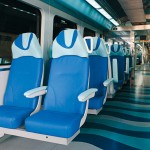By Peter Harrison www.business.maktoob.com
DUBAI – Dubai’s metro inched closer to full operation this weekend with the opening of seven more stations, but despite a limited service, construction delays and annoying carriage music it has managed to win over car addicts and prove doubters wrong.

However, the metro’s biggest test is yet to come. With the summer months approaching many observers will be looking to see whether residents will suffer the scorching temperatures to walk to stations or just get back behind the wheel.
The metro has carried some 2.5 million passengers since its launch in September, averaging around 80,000 passengers a day, despite only having a third of the 29 stations on the Red Line open for much of that time.
During rush hour train carriages are bustling with commuters, while weekends see a steady stream of passengers making their way between the numerous shopping centres dotted along the line.
“I said I’d never ride the metro when it opened, but I’ve ended up using it quite often, it’s pretty convenient,” said Daniel Jones, a 34-yaer-old British sales manager. “I don’t use it to travel to work, but on the weekend I use it to go between malls.”
A straw poll carried out by Maktoob News on May 2 found all respondents had either already ridden or intended to ride the metro.
PICTURE OF SUCCESS
The picture is very different from one of empty trains painted by doubters when the metro launched, who said scorching temperatures and residents’ love for their cars doomed it to failure.
“The metro has been a great success. It has become very popular with a broad spectrum of the population,” said Peyman Parham, director of marketing and corporate communications at the Roads and Transport Authority (RTA).
The metro has been particularly popular with low-wage earners, with inner city stations such as Union Square in Deira and Khalid Bin Al Waleed in Bur Dubai among the most frequented.
“I have no intention of driving,” said Kenyan Ahmed Mohammed, who works at Mall of the Emirates, famed for its indoor ski slope. “My journey to the mall from Al-Rigga (in Deira) takes about half an hour, it’s stress free and quite cheap.”
But Rashidiya and Nakheel Harbour & Tower, commuter stations at either end of the line, have also seen significant footfall as motorists abandon their vehicles to avoid a gruelling drive across the city.
The opening of the new stations, eight months after the metro’s glitzy launch in September, brings the total number in operation on the 52-km Red Line to 18, with the remaining 11 stations set to come online sometime before the end of the year.
NEW TEST
Several of the stations are located close to more affluent residential districts and will be a test to see if they can general the same football as inner city stations, but the signs are positive.
“This is the first time I have used the metro since it launched and I will certainly use it again, it is much faster and more pleasant than driving,” said Ruby Elbazri, a 32-year-old Egyptian analyst who lives in Dubai Internet City, the location of one of the new stations.
“It has been quite frustrating up until now watching trains run through the station without stopping,” she added.
The opening of the stations have been delayed due to a long-running row between the Roads and Transport Authority (RTA) and the Japanese-led consortium building the metro over who should pay for extra costs, which have ballooned due to changes to designs and the addition of new stations and facilities.
Completion of the second Green Line, which will run between Al-Qusais and Al-Jadaf, was originally scheduled for March, but has been pushed back to August 2011.
SWELTERING SUMMER
The RTA seems to have put the pay dispute behind it after reaching a deal with the consortium in March, but now faces an even sterner test with the summer months fast approaching.
“I don’t think I will during the summer. I don’t live particularly close to any of the stations and in the heat of summer I just would be comfortable,” said Italian Lucrezia Morleo, 37, moved to the city late in April.
Temperatures in Dubai can reach as high as 50 degrees Celsius in the summer and residents are reluctant to spend time out in the heat unless there is no alternative.
The summer also sees many residents leave for extended holidays and the number of tourists visiting the city dwindles.
“I suspect the ridership will not increase during the summer, it might drop slightly or stay the same. It will be hard to tell the metro’s exact worth until September, when temperatures start to drop and people return,” Fabio Scacciavillani, an economist at the Dubai International Financial Centre (DIFC).
















